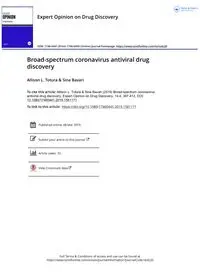
2019 Broad-spectrum coronavirus antiviral drug discovery PDF
Preview 2019 Broad-spectrum coronavirus antiviral drug discovery
Full Terms & Conditions of access and use can be found at https://www.tandfonline.com/action/journalInformation?journalCode=iedc20 Expert Opinion on Drug Discovery ISSN: 1746-0441 (Print) 1746-045X (Online) Journal homepage: https://www.tandfonline.com/loi/iedc20 Broad-spectrum coronavirus antiviral drug discovery Allison L. Totura & Sina Bavari To cite this article: Allison L. Totura & Sina Bavari (2019) Broad-spectrum coronavirus antiviral drug discovery, Expert Opinion on Drug Discovery, 14:4, 397-412, DOI: 10.1080/17460441.2019.1581171 To link to this article: https://doi.org/10.1080/17460441.2019.1581171 Published online: 08 Mar 2019. Submit your article to this journal Article views: 33 View Crossmark data REVIEW Broad-spectrum coronavirus antiviral drug discovery Allison L. Totura and Sina Bavari Division of Molecular and Translational Sciences, United States Army Medical Research Institute of Infectious Diseases, Fort Detrick, MD, USA ABSTRACT Introduction: The highly pathogenic coronaviruses severe acute respiratory syndrome coronavirus (SARS-CoV) and Middle East respiratory syndrome coronavirus (MERS-CoV) are lethal zoonotic viruses that have emerged into human populations these past 15 years. These coronaviruses are associated with novel respiratory syndromes that spread from person-to-person via close contact, resulting in high morbidity and mortality caused by the progression to Acute Respiratory Distress Syndrome (ARDS). Areas covered: The risks of re-emergence of SARS-CoV from bat reservoir hosts, the persistence of MERS-CoV circulation, and the potential for future emergence of novel coronaviruses indicate antiviral drug discovery will require activity against multiple coronaviruses. In this review, approaches that antagonize viral nonstructural proteins, neutralize structural proteins, or modulate essential host ele- ments of viral infection with varying levels of efficacy in models of highly pathogenic coronavirus disease are discussed. Expert opinion: Treatment of SARS and MERS in outbreak settings has focused on therapeutics with general antiviral activity and good safety profiles rather than efficacy data provided by cellular, rodent, or nonhuman primate models of highly pathogenic coronavirus infection. Based on lessons learned from SARS and MERS outbreaks, lack of drugs capable of pan-coronavirus antiviral activity increases the vulnerability of public health systems to a highly pathogenic coronavirus pandemic. ARTICLE HISTORY Received 16 August 2018 Accepted 7 February 2019 KEYWORDS Antiviral; ARDS; acute respiratory distress syndrome; bat; broad- spectrum; camel; civet; coronavirus; emerging virus; highly pathogenic virus; human cases; interferon; in vitro model; lopinavir; MERS; MERS-CoV; Middle East respiratory syndrome; pneumonia; primate model; respiratory; ribavirin; rodent model; SARS; SARS-CoV; severe acute respiratory syndrome; therapeutic; zoonosis; zoonotic 1. Introduction Outbreaks of severe acute respiratory syndrome (SARS, 2002–2004 [1,2]) and Middle East respiratory syndrome (MERS, 2012-current [3]) in the last two decades are a significant threat to global public health. SARS and MERS represent a new class of public health concern that may continue to emerge into human populations: respiratory syn- dromes caused by coronaviruses (CoVs) that are transmitted from person-to-person via close contact, resulting in high morbidity and mortality in infected individuals. Although SARS and MERS initially present as mild, influenza-like illnesses with fever, dyspnea, and cough, progression to more severe symptoms is characterized by an atypical interstitial pneumo- nia and diffuse alveolar damage. Both SARS-CoV and MERS- CoV are capable of causing acute respiratory distress syn- drome (ARDS), the most severe form of acute lung injury where alveolar inflammation, pneumonia, and hypoxic lung conditions lead to respiratory failure, multiple organ disease, and death in 50% of ARDS patients [4]. The total confirmed number of patients infected with highly pathogenic CoVs is relatively low (approximately 10,000 cases of both SARS and MERS since 2002), but CoVs are of particular concern due to high case fatality rates, lack of proven therapeutics, as well as the demonstrated ability of these pathogens to seed out- breaks that rapidly cross geographic and geopolitical borders into other countries and continents [5,6]. 1.1. Coronaviridae phylogeny and emergence Highly pathogenic coronaviruses SARS-CoV and MERS-CoV recently emerged into human populations, but other human coronaviruses (HCoVs) including HCoV-OC43, HCoV-229E, HCoV-NL63, and HCoV-HKU1 are estimated to have circulated in human populations for hundreds of years, causing mild respiratory illness to which approximately 5–30% of ‘common colds’ are attributed [7,8]. Within the Coronaviridae family (order Nidovirales) four genera are recognized: alphacorona- virus, betacoronavirus, gammacoronavirus, and deltacorona- virus. The six HCoVs (Table 1) currently identified belong to the genera alphacoronavirus (HCoV-229E and HCoV-NL63) and betacoronavirus (SARS-CoV, MERS-CoV, HCoV-OC43, and HCoV-HKU1). Gammacoronaviruses and deltacoronaviruses have no known viruses that infect humans, but contain impor- tant agricultural pathogens of livestock. Epizootic corona- viruses in animals cause a wide range of disease signs resulting from respiratory, enteric, and neurological tissue tropism. Although HCoVs cause primarily respiratory symp- toms, the potential for a wide range of severe disease symp- toms in humans caused by infection by future emergent coronaviruses cannot be excluded. Despite the severity and diversity of coronavirus disease signs and symptoms affecting a large number of important livestock species as well as humans, there are no proven therapies that specifically target CoVs. CONTACT Sina Bavari
